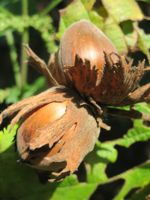Mon-Fri 9am - 5pm Mountain time
Korean Boxwood vs European Hazelnut
Buxus microphylla Koreana
Corylus avellana
CUSTOM GROW
NOT AVAILABLE THIS SEASON - MIGHT RETURN
Korean Boxwood is a vibrant evergreen shrub. A top choice for colder climates, this shrub will look stunning lining a driveway or as a foundation plant.
Easy to root in and maintain, Korean Boxwood's thick foliage is deer resistant and turns an attractive yellow-brown to purplish in winter. Consider applying mulch around the base to keep the roots moist and cool.
European Hazelnut is a large shrub that is native to Europe. It is known for its edible nuts that ripen in late summer to early fall. The nuts can be eaten raw or roasted and have a sweet, earthy flavour. Nut production can start as early as 2-3 years but typically takes until at least 4 years for significant yields.
Catkins appear in late winter to early spring and as they release pollen it attracts bees and other pollinators. Since male and female flowers bloom at different times, multiple shrubs will have to be planted for cross pollination. It is recommended to plant European Hazelnut with other hazelnut varieties such as Beaked Hazelnut, Frank, Yamhill, and York. Planting with other varieties will increase nut production.

